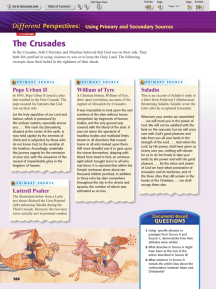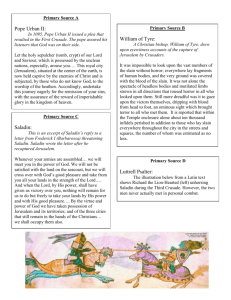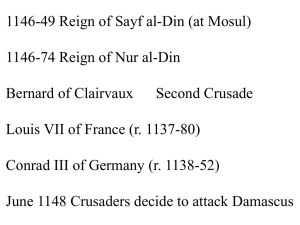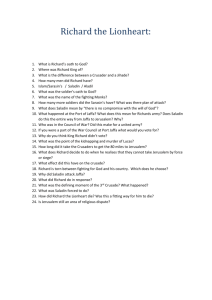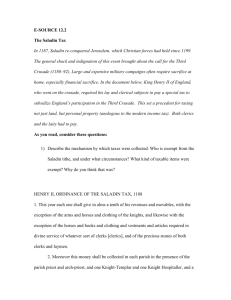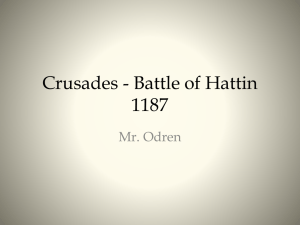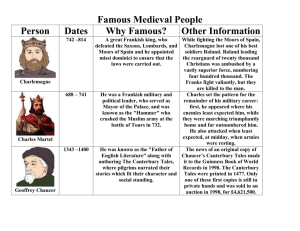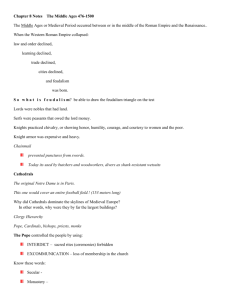Writer Thorvald Steens lecture at the PEN
advertisement
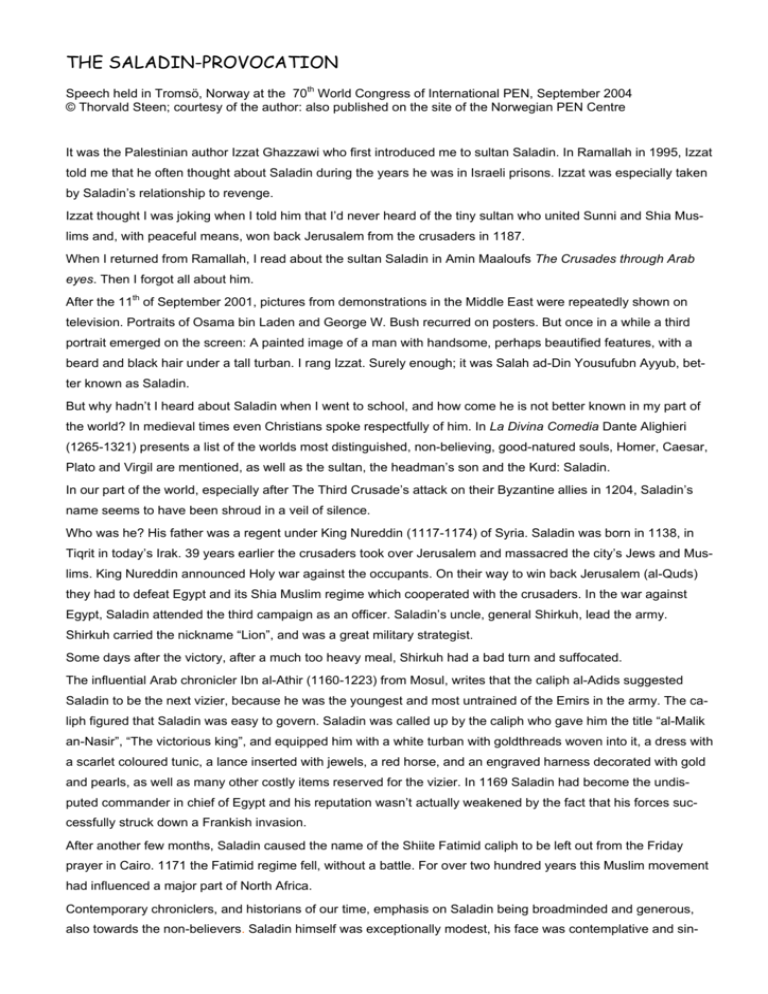
THE SALADIN-PROVOCATION Speech held in Tromsö, Norway at the 70th World Congress of International PEN, September 2004 © Thorvald Steen; courtesy of the author: also published on the site of the Norwegian PEN Centre It was the Palestinian author Izzat Ghazzawi who first introduced me to sultan Saladin. In Ramallah in 1995, Izzat told me that he often thought about Saladin during the years he was in Israeli prisons. Izzat was especially taken by Saladin’s relationship to revenge. Izzat thought I was joking when I told him that I’d never heard of the tiny sultan who united Sunni and Shia Muslims and, with peaceful means, won back Jerusalem from the crusaders in 1187. When I returned from Ramallah, I read about the sultan Saladin in Amin Maaloufs The Crusades through Arab eyes. Then I forgot all about him. After the 11th of September 2001, pictures from demonstrations in the Middle East were repeatedly shown on television. Portraits of Osama bin Laden and George W. Bush recurred on posters. But once in a while a third portrait emerged on the screen: A painted image of a man with handsome, perhaps beautified features, with a beard and black hair under a tall turban. I rang Izzat. Surely enough; it was Salah ad-Din Yousufubn Ayyub, better known as Saladin. But why hadn’t I heard about Saladin when I went to school, and how come he is not better known in my part of the world? In medieval times even Christians spoke respectfully of him. In La Divina Comedia Dante Alighieri (1265-1321) presents a list of the worlds most distinguished, non-believing, good-natured souls, Homer, Caesar, Plato and Virgil are mentioned, as well as the sultan, the headman’s son and the Kurd: Saladin. In our part of the world, especially after The Third Crusade’s attack on their Byzantine allies in 1204, Saladin’s name seems to have been shroud in a veil of silence. Who was he? His father was a regent under King Nureddin (1117-1174) of Syria. Saladin was born in 1138, in Tiqrit in today’s Irak. 39 years earlier the crusaders took over Jerusalem and massacred the city’s Jews and Muslims. King Nureddin announced Holy war against the occupants. On their way to win back Jerusalem (al-Quds) they had to defeat Egypt and its Shia Muslim regime which cooperated with the crusaders. In the war against Egypt, Saladin attended the third campaign as an officer. Saladin’s uncle, general Shirkuh, lead the army. Shirkuh carried the nickname “Lion”, and was a great military strategist. Some days after the victory, after a much too heavy meal, Shirkuh had a bad turn and suffocated. The influential Arab chronicler Ibn al-Athir (1160-1223) from Mosul, writes that the caliph al-Adids suggested Saladin to be the next vizier, because he was the youngest and most untrained of the Emirs in the army. The caliph figured that Saladin was easy to govern. Saladin was called up by the caliph who gave him the title “al-Malik an-Nasir”, “The victorious king”, and equipped him with a white turban with goldthreads woven into it, a dress with a scarlet coloured tunic, a lance inserted with jewels, a red horse, and an engraved harness decorated with gold and pearls, as well as many other costly items reserved for the vizier. In 1169 Saladin had become the undisputed commander in chief of Egypt and his reputation wasn’t actually weakened by the fact that his forces successfully struck down a Frankish invasion. After another few months, Saladin caused the name of the Shiite Fatimid caliph to be left out from the Friday prayer in Cairo. 1171 the Fatimid regime fell, without a battle. For over two hundred years this Muslim movement had influenced a major part of North Africa. Contemporary chroniclers, and historians of our time, emphasis on Saladin being broadminded and generous, also towards the non-believers. Saladin himself was exceptionally modest, his face was contemplative and sin- cere. Saladin was entitled to live in the caliph’s luxurious palace in Cairo. But Saladin chose to move into the rather Spartan vizier-residence. Judged by appearance, Saladin was a tiny and slim man, with a short cut, even beard, and he accurately obeyed the commands of every religion. In addition he had the same goal as the deceased Syrian king and leader; Nureddin: To unite the Arab and the Muslim world, and to recapture Jerusalem which the crusaders took in 1099. After the massacre of Jews and Muslims in Jerusalem, only Christians were allowed to practise their belief in the Holy city of the three world religions. Saladin survived several murder attempts by the Assassins as well as various battles against the Frankish crusaders. At the same time he consolidated his position as sole sovereign of the Egyptian-Syrian Empire. In stead of immediately taking Jerusalem back from the Franks, Saladin formed an alliance with those of the Franks who wanted a peaceful co-existence. One of them was count Raymond of Tripoli, who spoke fluent Arabic and was eagerly preoccupied with Arabic literature and Islamic texts. Both camps were tired of making war. The truce lasted for three years and business thrived. In spite of several grotesque examples of the Franks’ plundering of Mecca, as well as other cities, Saladin did not launch an attack on Jerusalem. But even Saladin had his limit. The duke and crusader Renaud de Châtillion repeatedly assaulted the Pilgrims, and Saladin could no longer justify the truce. He encouraged all Muslims to come to Damascus. Holy war was proclaimed. After a few days the city was besieged by tents made of camel’s hair, princely pavilions in rich coloured textiles embroidered with verses from the Koran and poems written in calligraphy. Arabic, Turkish and Kurdish soldiers flocked to Damascus. Count Raymond was forced by his own, the Christians, to join in the great Battle of Hattin, a battle the Christian fundamentalists looked forward to. While fighting, Saladin let count Raymond escape to Tripoli. After having conquered the crusaders in Hattin in July 1187, Saladin took the Citadel in Tiberias and the seaport of Acre. Both places the defenders were free to go to Tripoli. Then, without resistance, fell Galilee, Samaria, Neblas, Haifa and Nazareth. Saladin was just about to reach his goal. He could glimpse the domes of Jerusalem. To avoid blood shedding, Saladin first allowed the Franks access to make their pilgrimage to Jerusalem. They refused. After a short war, the Franks were forced to surrender. Friday the 2nd of October 1187, the 27th day of Rajab in the year 583 after Hidjra, on the same day the Muslims celebrate Mohammed’s night travels to Jerusalem, Saladin made his solemn march into the Holy city. Saladin decided that neither Frankish Christians, nor the ones of oriental heritage should be pursued. Saladin placed guards around the church of the Holy grave as well as other holy places belonging to the non-Muslims, to avoid them being destroyed. Saladin encouraged the Franks to stay, and invited Jewish families to move back in to Jerusalem. Saladin’s tax collectors were shocked by the fact that their leader allowed Franks, and others who wanted to leave Jerusalem, to depart without returning goods they had stolen. Firstly, Saladin said, it will be difficult to prove what is actually plundered, and secondly; he had not taken the city to enrich himself on material wealth. Saladin let al-Aqsa, which was previously turned into a church, once again become a mosque after having the walls sprinkled with rose-water. Then Saladin let the slaves free without them having to pay, further on he proclaimed that he would not take a ransom for the richest. Some of his trusted men objected loudly. Saladin answered them: “Christians throughout the world will remember the good deeds we have done for them." The historian Ibn a-Athir was fairly reserved towards Saladin’s broadminded behaviour. The Franks whom Saladin let escape, had gathered in the city of Tyr. The West was not willing to give up. In April 1191, the Frankish king Philippe Augustus disembarked close to Acre, followed by Richard I the Lion-Heart (1157-1199), king of England, in June. In Acre Richard Lion-Heart, the man that I in my childhood -- through books like Robin Hood and Ivanhoe -- learned to know as the most outstanding representative of chivalry, massacred 3000 Muslims. Saladin let Richard’s commanders go on a pilgrimage to Jerusalem, and many of them accepted the offer. But Richard the Lionheart, who more than once tried to meet the legendary Saladin, refused to go to the Holy city. He returned to England and never came back. The 3rd of March 1193 Saladin died, 55 years old, in Damascus, peacefully sitting under an olive tree in the garden. Perhaps Izzat Ghazzawi was right when he said that the world has never raised a greater agitator for tolerance and pluralism. Saladin’s provocation towards his own time, and also on us, are his actions towards “the others”. No one, either Sunni, Shia Muslim, Jew or Christian, was able to question his generosity towards people who had a different belief than Saladin himself, something which also must be a paradox to many of the Muslim fundamentalists nowadays. No one, either an author or not, serves his case best by being imprisoned. According to Izzat the romantic “stay in prison philosophy” ignores that the world does not need fewer spokesmen like Saladin, but rather more of them, outside the prison walls. “Martyrs may surely have an essential role, but the ones building bridges are of a greater significance.” What made this determined believer, this Muslim, undertake all those merciful and tolerant decisions throughout his life? And what kind of battles were fought in Saladin’s head when he was betrayed by “the others”, or the nonbelievers, whom he had shown his generosity, or even by his own people? Who was he? What kept him going? Why do we so rarely experience someone who has the whole of humanity as his own concern? To get closer to an answer, I could not make use of reference books. I wrote the novel Kamelskyer.
